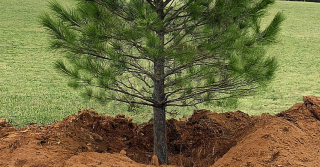If you've ever considered moving or transplanting pine trees on your property, you're not alone.
Many homeowners and landscapers find themselves in a situation where they need to relocate these majestic evergreens. However, the key to a successful pine tree transplant is understanding the optimal timing and proper techniques.
In this guide, brought to you by Strobert Tree Services, leaders in tree care across Delaware, Pennsylvania, Maryland, and New Jersey, we'll explore the best time for transplanting pine trees and provide insights into ensuring a smooth transition for these iconic arboreal wonders.
Understanding Pine Trees
Before delving into the intricacies of transplanting pine trees, it's crucial to understand the unique characteristics of these conifers. Pine trees, belonging to the Pinus genus, are known for their needle-like leaves and iconic cones. They are hardy trees that adapt well to various climates, making them a popular choice in landscaping. However, despite their resilience, moving them requires careful consideration and planning.
The Best Time for Transplanting Pine Trees
Early Spring or Late Fall: Ideal Seasons
Transplanting pine trees is a delicate process, and timing plays a pivotal role in ensuring the tree's successful establishment in its new location. The best times for transplanting pine trees are typically early spring or late fall. During these periods, the tree is dormant, which reduces the stress and shock associated with the move. Spring and fall also provide moderate temperatures and ample soil moisture, creating optimal conditions for root establishment.
Factors Influencing Transplant Success
Tree Age and Size
The age and size of the pine tree are significant factors influencing the success of the transplant. Younger trees with smaller root systems tend to adapt more quickly to relocation. However, if you must move a mature pine tree, it's essential to take extra precautions and consider enlisting professional tree care services.
Weather Conditions
While spring and fall are generally the best seasons for transplanting pine trees, paying attention to the local weather conditions is crucial. Avoid transplanting during periods of extreme heat or drought, as these factors can increase stress on the tree. Similarly, be cautious of frost or freezing temperatures in late fall, which can impede root establishment.
Step-by-Step Guide to Transplanting Pine Trees
1. Assess the Tree
Before initiating the transplant, thoroughly assess the health of the pine tree. Look for signs of disease, pest infestations, or stress. It's advisable to consult with a professional arborist, such as Strobert Tree Services, to ensure the tree is suitable for transplantation.
2. Prepare the New Location
Ensure that the new planting site has well-draining soil and receives adequate sunlight. Dig a hole twice the width of the tree's root ball and at the same depth. Amend the soil with organic matter to promote healthy root growth.
3. Prune Excess Foliage
Pruning excess foliage reduces stress on the tree during the transplant. Focus on removing any damaged or dead branches. This not only aids in transportation but also encourages the tree to allocate energy to root development.
4. Carefully Extract the Tree
Using a sharp shovel, carefully excavate the tree, ensuring you preserve as much of the root ball as possible. Lift the tree by the root ball rather than the trunk to minimize stress on the tree.
5. Transport and Replant
Transport the tree to its new location promptly. Gently place it in the prepared hole, ensuring it sits at the same depth as in its previous location. Backfill the hole with soil and water thoroughly, and apply a layer of mulch to conserve moisture.
6. Post-Transplant Care
After transplanting:
- Monitor the tree closely for signs of stress.
- Water it regularly, especially during the first growing season.
- Consider applying a slow-release fertilizer to support healthy growth.
Contact Strobert Tree Services - Leaders in Delaware Tree Care
Transplanting pine trees is a meticulous process that requires careful consideration of timing, tree health, and environmental factors. By adhering to the recommended guidelines and seeking professional assistance from tree care experts Strobert Tree Services, you can ensure a successful transition for these iconic evergreens. Whether you're enhancing your landscape or addressing specific needs, proper transplanting techniques will contribute to your pine trees' long-term health and vitality.











